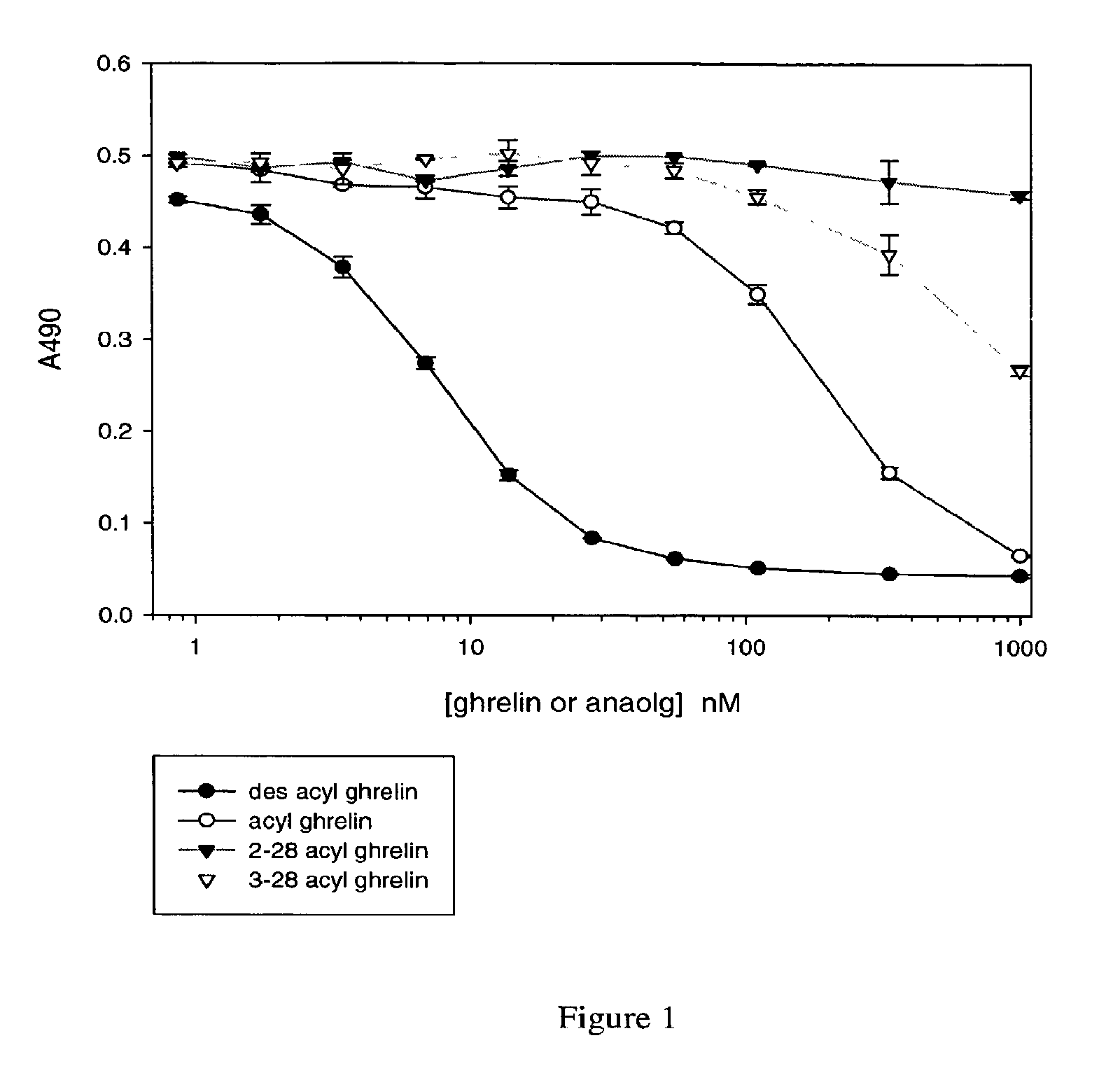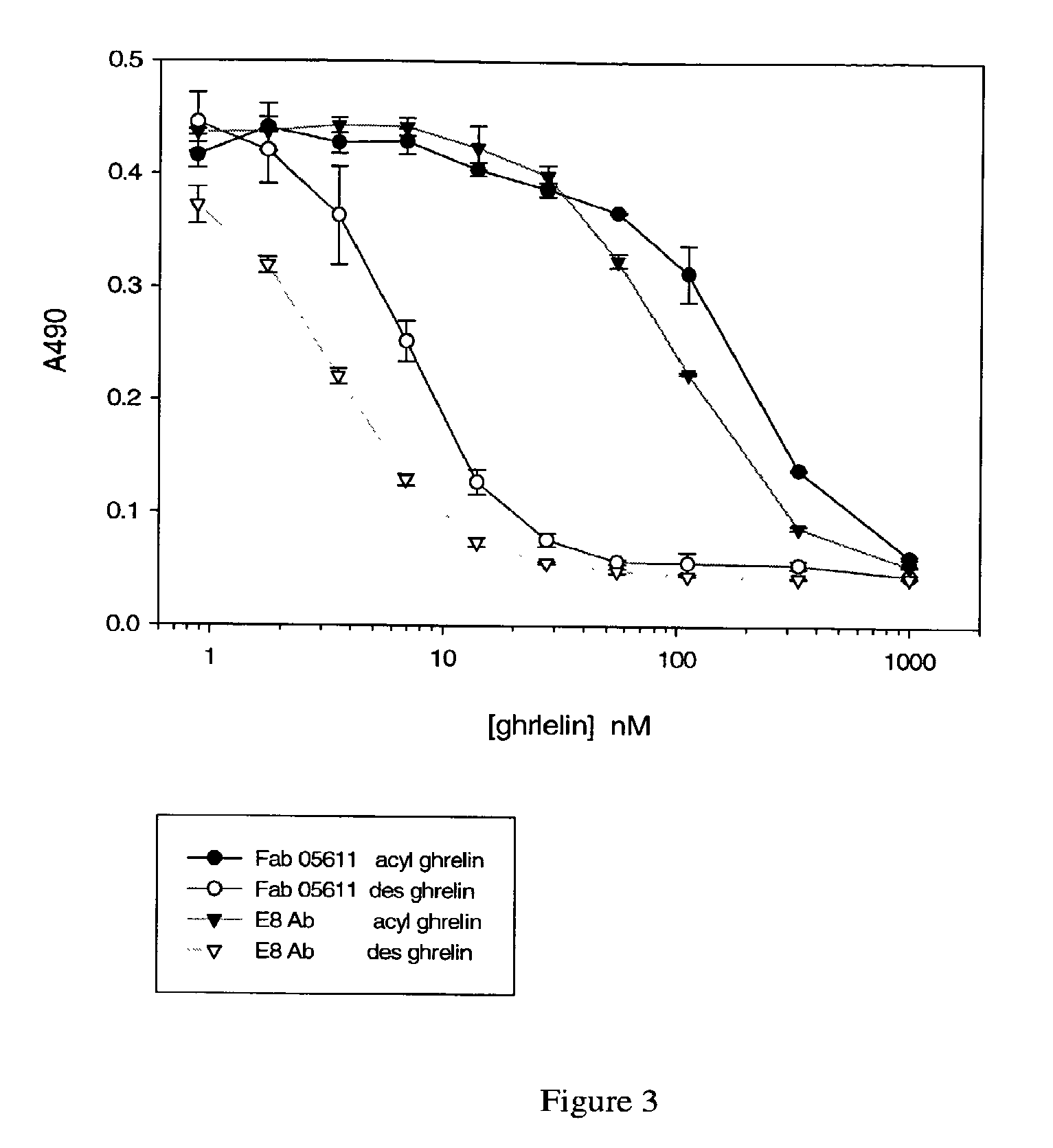Desacyl ghrelin antibodies and therapeutic uses thereof
a desacyl ghrelin and monoclonal antibody technology, applied in the field of medicine, can solve the problems of limited treatment for obesity, largely unsuccessful treatment, and failure rate of 95%, and achieve the effects of reducing the level of desacyl ghrelin
- Summary
- Abstract
- Description
- Claims
- Application Information
AI Technical Summary
Benefits of technology
Problems solved by technology
Method used
Image
Examples
example 1
Anti-Desacyl Ghrelin Fab and Monoclonal Antibody Synthesis
Fab Synthesis
[0144]The CDR and framework sequences disclosed herein are identified from clones of Fab fragments isolated from antibody libraries generated from antibody RNA created by immunized C57B16 wild-type mice using Omniclonal™ antibody technology (Biosite®, San Diego, Calif.). The mice are immunized with human ghrelin acylated with n-octanoic acid at the His residue at position 9 (SEQ ID NO: 17). To improve the immunogenicity of this peptide, keyhole limpet hemocyanin is conjugated to the peptide through a C-terminal cysteine according to standard methods.
[0145]Table 1 shows the nucleic acid and corresponding amino acid sequences of the LCVR and CDRs 1, 2, and 3, contained therein, as well as the HCVR and CDRs 1, 2, and 3 contained therein, of Fab 5611. The CDR nucleic acid coding regions within the LCVR and HCVR are underlined.
TABLE 1Fab 5611 Nucleic Acid and Amino Acid SequencesSEQNO:DESCRIPTIONSEQUENCE 1DNA LCVRTCTA...
example 2
[0149]Desacyl ghrelin is dried onto the surface of a Greiner MultiBind microtiter plate
[0150](450-655061) by adding 60 uL of a 0.4 μg / ml (in H2O) solution to each well. The assay plate is placed in a dry 37° C. incubator overnight. The next day, the assay plate is washed (wash buffer: 0.1% Tween 20, Tris-buffered saline (TBS)), and blocked with casein / PBS (Pierce 37528).
[0151]Ghrelin or ghrelin analogs are combined at various concentrations (see FIGS. 1-3) with Fab 5611 at 10 nM, or with the E8 monoclonal antibody at 10 nM (see FIG. 3), in casein / PBS. “2-28 acyl ghrelin” and “3-28 acyl ghrelin” in FIG. 1 refer to acyl ghrelins (SEQ ID NO: 17) missing the first one or two amino acids at the N-terminal end of the molecule, respectively. In FIG. 2, “1-8 (cys) desacyl” refers to a desacyl ghrelin fragment consisting of amino acids 1-8 of SEQ ID NO: 17, with an additional cysteine residue at the C-terminus. “4-28 (cys)” refers to a ghrelin fragment consisting of amino acids 4-...
example 3
Affinity Measurement of Monoclonal Fabs and Antibodies
[0159]The affinity (KD) and Kon and Koff rates of anti-desacyl ghrelin Fabs and monoclonal antibodies of the present invention are measured using a BLAcore® 2000 instrument containing a CM5 sensor chip. The BIAcore® utilizes the optical properties of surface plasmon resonance to detect alterations in protein concentration of interacting molecules within a dextran biosensor matrix. Except where noted, all reagents and materials are purchased from BIAcore® AB (Upsala, Sweden). All measurements are performed at 25° C. Samples containing rat or human desacyl ghrelin are dissolved in HBS-EP buffer (150 mM sodium chloride, 3 mM EDTA, 0.005% (w / v) surfactant P-20, and 10 mM HEPES, pH 7.4). A capture antibody, goat anti-mouse Kappa (Southern Biotechnology, Inc), is immobilized onto flow cells using amine-coupling chemistry. Flow cells (1-4) are activated for 7 minutes with a 1:1 mixture of 0.1 M N-hydroxysuccinimide and 0.1 M 3-(N,N-dime...
PUM
| Property | Measurement | Unit |
|---|---|---|
| Light | aaaaa | aaaaa |
Abstract
Description
Claims
Application Information
 Login to View More
Login to View More - R&D
- Intellectual Property
- Life Sciences
- Materials
- Tech Scout
- Unparalleled Data Quality
- Higher Quality Content
- 60% Fewer Hallucinations
Browse by: Latest US Patents, China's latest patents, Technical Efficacy Thesaurus, Application Domain, Technology Topic, Popular Technical Reports.
© 2025 PatSnap. All rights reserved.Legal|Privacy policy|Modern Slavery Act Transparency Statement|Sitemap|About US| Contact US: help@patsnap.com



